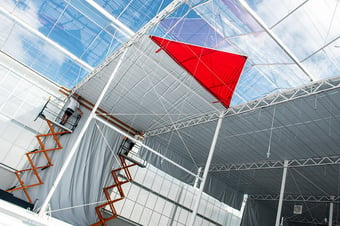Step 1: Where is your greenhouse located?
The first step to consider is the location of your greenhouse, since climate conditions can vary greatly depending on the area. In which country and region is your greenhouse located? What are the macro weather conditions? Is it primarily cold or warm, sunny or overcast, and is the length of daylight longer or shorter?
Understanding the typical weather patterns and ranges can help you to determine which screen or combination of screens will best suit your greenhouse. Bespoke solutions can be created for your greenhouse that take into account the variety of factors that affect the conditions inside it.
Step 2: Factors above the screen
A very important factor is the type of greenhouse structure you have, as it needs to be able to have screens mounted on it. Installing a greenhouse in a traditional Venlo structure requires a different set-up than polycarbonate greenhouses or widespan structures. An experienced screen system installer can help you to determine what type of screen installation is suitable for your greenhouse.
Next, the type of structure also influences the climatic behaviour inside the controlled environment, includingthe factors above the screen. The type of greenhouse you have will also influence how much light the actual structure is blocking. This information will affect the selection and setup of the climate screen.
Step 3: Factors below the screen
Then it’s time to take a look at factors below the screen. These include the number of heating pipes per bay, whether artificial lighting systems are used, whether crop support wires have been installed, and whether other structures or equipment in the greenhouse block sunlight. Each of these can contribute to inconsistent conditions inside the greenhouse.
To get the most out of your climate screens, you not only need to look at the factors that may impact the effectiveness of each screen, but also consider how many screens you want (one, two or three), and how many can be installed in your greenhouse. More screens will require a larger investment, but could provide greater control over the climate, and energy usage, leading to higher yields, better quality and more sustainable production.
Step 4: The type of crop you grow
The final consideration is the type of crop you grow and the marketing of your production. Off-season production requires a different climate strategy than regular seasonal production. The cropping plan and the crop type greatly affect the choice of screening. Cultivation and production methods used can also affect your choice.
Screens can provide a plant-centric solution that creates the best climate conditions for each individual crop and production planning, so it can thrive and produce the best possible yields for growers when they need.
Climate screens product sheet
Are you ready to talk to one of our specialists about which climate screen system would suit your situation best? Contact one of our climate experts at Ridder. They can tell you more about how climate screens can help create the ideal environment for your greenhouse. And in collaboration with your screen installer, we can give you a tailored advice.
Do you want to read further about your options in climate screens? We have created the perfect product sheet where you'll find:
- The 5 factors you need to take into account when choosing the right climate 
- The different types of climate screens;
- What screen is right for your greenhouse or specific situation;
Get access to the product sheet here.




